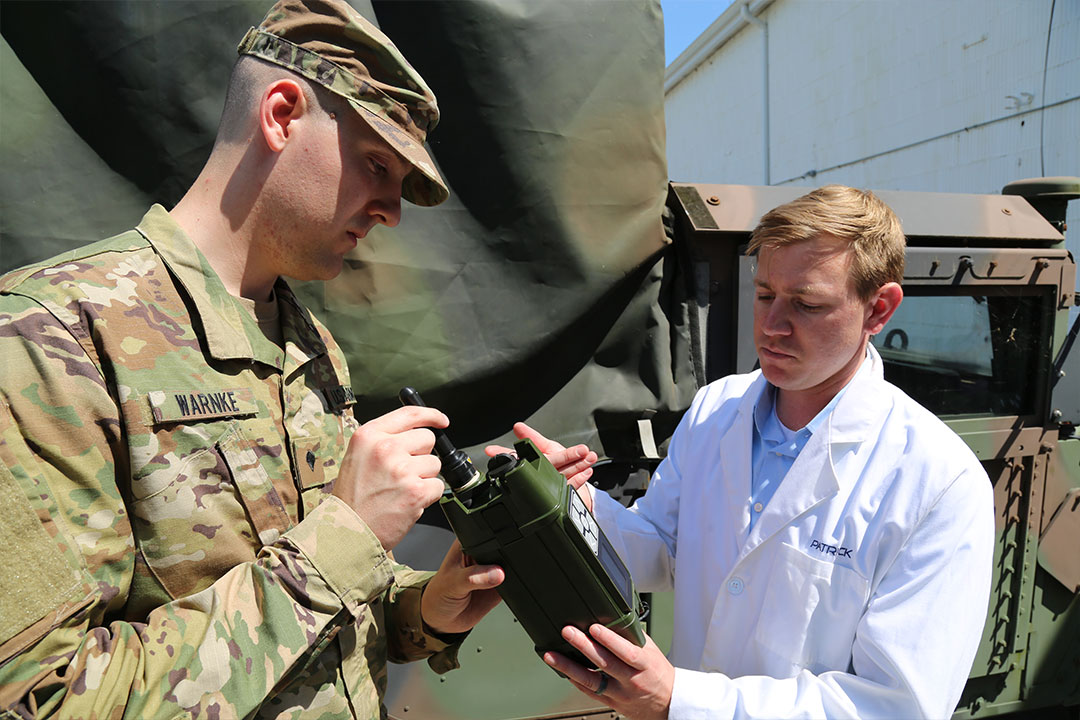// NEWS RELEASE
New JCAD model tests for opioids, illegal drugs
New JCAD model tests for opioids, illegal drugs
CCDC Chemical Biological Center Public Affairs | August 7th, 2018
New JCAD model tests for opioids, illegal drugs
New JCAD model tests for opioids, illegal drugs
DEVCOM CBC Public AffairsAugust 7th, 2018

A warfighter handles a JCAD SLA during a field test conducted in June 2018. (Photo credit: Jack Bunja/RDECOM C&B Center.)
The Joint Chemical Agent Detector (JCAD), a longtime tool to detect chemical warfare agent (CWA) in the field, is undergoing modifications to detect illegal drugs, including opioids like heroin and fentanyl.
This upgrade, developed by the U.S. Army Research, Development, and Engineering Command Chemical & Biological Center (RDECOM C&B), comes concurrently with modifications enabling the JCAD to detect explosive compounds. Both capabilities are expected to undergo field testing in the coming months, giving warfighters the chance to demonstrate the technology and provide feedback to its developers.
Referred to as the JCAD Solid Liquid Adapter (SLA), the new model was developed to give warfighters the ability to test for additional threats without creating another, separate device. Explosive detection capabilities are added by placing the JCAD into a cradle with additional software.
“There was the desire to take something that was already fielded and expand its capabilities without changing its hardware or requiring additional equipment,” said Mary Wade, branch chief for detection spectrometry, noting that every Army unit is equipped with a JCAD.
In addition to serving the warfighter, the JCAD SLA is also expected to help law enforcement officers and first responders with its opioid-detection capability.
“The opioid crisis has caused so many deaths in the community, and law enforcement is looking for help,” Wade said. “Last year, Aberdeen Proving Ground hosted an opioid summit as part of its commitment to fighting this epidemic, and our hope is that this technology helps law enforcement do their job even better.”
Patrick Riley, a research chemist involved in the project, said drug detection is becoming a greater emphasis among law enforcement experts fighting this epidemic.
“There’s an important shift to being able to detect these compounds in the field,” he said.
In addition to testing for opioids, the JCAD SLA will be able to test for cocaine, methamphetamine, and tetrahydrocannabinol (THC), the active ingredient in marijuana.
“With the legalization of marijuana in a lot of states, there really isn’t a breathalyzer-like test to determine intoxication, so that’s another thing we were looking at,” Riley said.
Soon, after additional tests, the capability will be put into the hands of warfighters and first responders.
“We probably have one more year before this is fielded,” Riley said, noting that the JCAD SLA is going to undergo a field demonstration coordinated by the Joint Project Manager for Nuclear, Biological, Chemical Contamination Avoidance (JPM NBC CA), which is funding the project in conjunction with an Army Technology Objective.
John Jump, JPM NBC CA’s system manager for survey and analytical systems, said that the JCAD SLA is “exactly what we’ve been looking for to address a gap in our detection capabilities.”
Past solid-liquid detectors were too large for field deployment, Jump said, but the JCAD SLA provides an effective alternative.
“The technology that we had been using was too big but this technology seems like it’s going to get the job done,” he said. “I believe this is really what the users have been looking for with the solid-liquid detector.”
A field demonstration is slated for this summer at Fort Bragg with units from the U.S. Army Special Operations Command (SOCOM).
“It’s primarily a human factors test,” Jump said. “We’re determining if the operators can use it effectively and how they proceed with the mission after detecting a threat.”
The U.S. Army Combat Capabilities Development Command (DEVCOM) leads in the discovery, development and delivery of technology-based capabilities to enable Soldiers to win our nation’s wars and come home safely. DEVCOM is a major subordinate command of the U.S. Army Futures Command. The DEVCOM Chemical Biological Center is the Army’s principal research and development center for chemical and biological defense technology, engineering and field operations. The DEVCOM Chemical Biological Center is headquartered at Aberdeen Proving Ground, Maryland.
